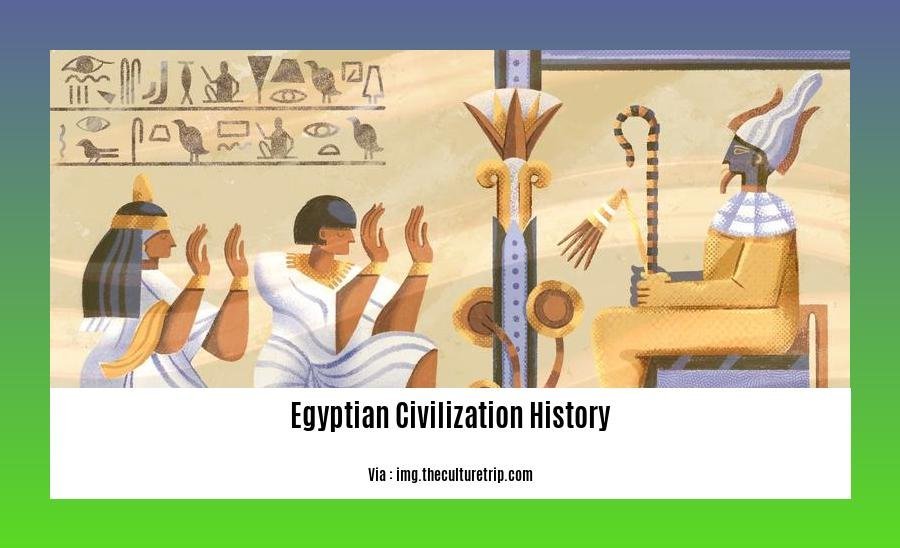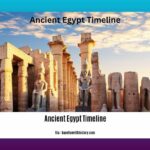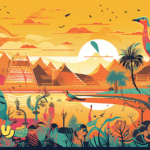Embark on an extraordinary journey through time as we delve into the enigmatic threads of Egyptian civilization in “Unveiling the Enigmatic Threads of Egyptian Civilization: A Historical Tapestry.” Together, we’ll unravel the intricate tapestry of its history, exploring the grandeur of its monuments and deciphering the captivating stories etched in hieroglyphs. Prepare to be captivated by the enduring legacy of this ancient civilization that continues to inspire and fascinate to this day.
Key Takeaways:
- Egyptian civilization gradually developed over 2,000 years in the Predynastic Period.
- King Menes established Memphis as the capital during the Archaic Period.
- The Old Kingdom was marked by pyramid construction, including the Step Pyramid.
- The First Intermediate Period witnessed a collapse of central authority and civil wars.
- Pharaohs were the rulers of ancient Egypt.
- Hieroglyphs and hieratic were the two forms of writing used in ancient Egypt.
- Snefru may have constructed the first true pyramid.
- Menes is thought to have united Upper and Lower Egypt.
- Howard Carter discovered Tutankhamun’s tomb in 1922.
Egyptian Civilization History
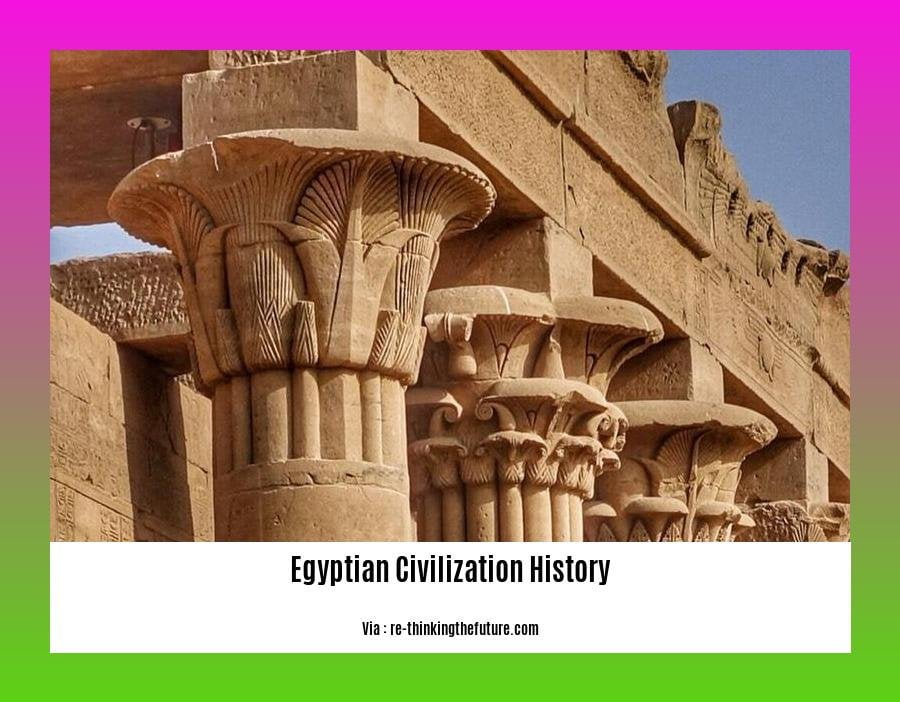
Let’s pull back the veil on the captivating Egyptian civilization history, a saga of architectural marvels and cultural brilliance that has left an indelible mark on humanity.
The Dawn of Civilization
Around 3100 BC, ancient Egypt emerged from the fertile banks of the Nile, where farming communities gradually coalesced into a unified kingdom. Unification under a single ruler, Pharaoh Menes, marked the dawn of the Egyptian civilization history.
Architectural Grandeur
The Egyptians were master builders, renowned for their monumental structures. The Great Pyramids of Giza, colossal tombs for pharaohs, stand as eternal testaments to their architectural prowess. Temples like Karnak and Luxor adorned with intricate hieroglyphics showcased their religious fervor and architectural ingenuity.
The Sacred and the Sphinx
Religion permeated every aspect of Egyptian life. They revered a pantheon of gods, including Amun-Ra, the sun god, and Osiris, the god of the underworld. The iconic Sphinx, a colossal half-human, half-lion statue, guarded the pyramids and symbolized the power and wisdom of the pharaohs.
The Power of Language
Egyptian scribes developed two writing systems: hieroglyphics, a formal script carved into stone, and hieratic, a cursive form used for everyday writing. These scripts recorded not only religious texts but also administrative records, providing a glimpse into the intricate workings of ancient Egypt.
Hierarchical Society
Egyptian society was highly structured, with the pharaoh at its apex. Below the pharaoh were nobles, priests, scribes, and commoners, each with their specific roles and privileges. This hierarchical system ensured the smooth functioning of the Egyptian civilization history.
Technological Advancements
The Egyptians made significant advancements in mathematics, astronomy, and medicine. They developed a solar calendar, mastered irrigation techniques, and had a sophisticated understanding of anatomy and surgery. Their knowledge laid the foundation for many scientific discoveries in later civilizations.
Legacy and Impact
The Egyptian civilization history left a lasting legacy on the world. Its architectural wonders continue to inspire awe, while its religious beliefs and cultural practices have influenced civilizations far and wide. The hieroglyphic script, once the language of pharaohs, became a key to unlocking the knowledge of the ancient world.
Egypt’s legacy is a testament to the ingenuity, creativity, and enduring spirit of a civilization that continues to captivate and inspire us today.
Dive into the history of ancient Egypt to uncover the enigmatic civilization that has captivated historians and explorers for centuries. Journey through the ancient Egypt timeline to witness the rise and fall of empires, the construction of iconic monuments, and the lives of legendary pharaohs. Delve into the egyptian pharaohs history to unravel the remarkable stories of Tutankhamun, Hatshepsut, and Ramses II, whose reigns shaped the course of ancient Egypt.
Complex Religious Beliefs and Mythology
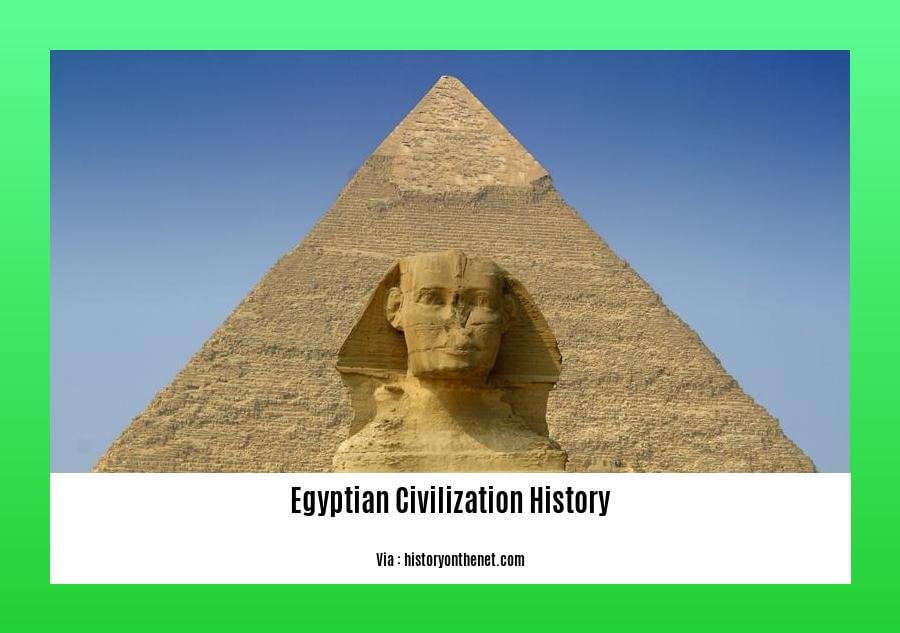
The tapestry of ancient Egypt is woven with intricate threads of religion and mythology, a testament to the profound spirituality that permeated every aspect of their lives. The Egyptians believed in an elaborate pantheon of gods, each with their own unique powers and roles in the cosmos. From the sun god Ra, who brought light and warmth, to the underworld deity Osiris, who presided over the afterlife, the gods were seen as active participants in human affairs.
Religious rituals and practices were central to Egyptian society. Elaborate temples, adorned with hieroglyphic inscriptions and towering statues, served as the focal point for worship. Priests performed daily rituals, presenting offerings and reciting hymns to invoke the favor of the gods. The pharaoh, considered the earthly embodiment of the gods, acted as an intermediary between the divine and mortal realms.
Beyond their deities, the Egyptians held a rich mythology that explained the origins of the world, the nature of the afterlife, and the role of humans in the cosmic order. Myths of creation, such as the story of Atum, the primordial god who emerged from the watery chaos, provide insights into the Egyptians’ beliefs about the beginning of time. The legend of Isis and Osiris, a tale of love, betrayal, and resurrection, offers a glimpse into their ideas about the afterlife and the power of justice.
The Complex Religious Beliefs and Mythology of the ancient Egyptians served as a guiding force, shaping their culture, art, and way of life. From the colossal pyramids that served as tombs for pharaohs to the intricate hieroglyphic texts that recorded their beliefs, the legacy of their spiritual world continues to fascinate and inspire us today.
Key Takeaways:
- The Egyptians practiced a polytheistic religion with over 1500 known deities.
- Deities were believed to control the world and interact with humans.
- Rituals and offerings were used to gain the favor of the gods.
- The pharaoh was considered a divine ruler and acted as an intermediary between the gods and people.
- Egyptian mythology provided explanations for the origins of the world and the nature of the afterlife.
Most Relevant URL Source:
Development of Writing and Literature
Storytelling, record-keeping, and the preservation of knowledge were essential to ancient Egyptians. Their Development of Writing and Literature left an indelible mark on the world:
Genesis of Hieroglyphics: Around 3200 BCE, Egyptians crafted hieroglyphics – a complex script of symbols representing words, syllables, and sounds.
Evolving Scripts: Hieroglyphics adorned temple walls and monuments, while a faster script called hieratic emerged for everyday writing. Later, demotic script simplified communication further.
Language of the Gods: Hieroglyphics were not just a means of communication but also a sacred language used in religious rituals and royal decrees.
Scribes and Literature
Literacy was revered in ancient Egypt. Scribes, highly trained officials, recorded historical events, religious texts, and literary masterpieces on papyrus scrolls.
Sages of the Time: Scribes were storytellers, poets, and philosophers, penning epics like “The Story of Sinuhe” and “The Book of the Dead.”
Wisdom in Papyrus: These writings explored themes of love, loss, and the afterlife, capturing the essence of Egyptian culture and thought.
Legacies in Stone: Inscriptions on temple walls and tombs immortalized the deeds of pharaohs and the beliefs of the people.
Key Takeaways:
- Hieroglyphics emerged as a complex script for monumental inscriptions.
- Hieratic and demotic scripts simplified writing for everyday use.
- Scribes were highly literate officials responsible for recording history and literature.
- Papyrus scrolls preserved epics, poems, and religious texts.
- Egyptian literature reflected themes of love, loss, and the afterlife.
Most Relevant URL Source:
Advanced Social Hierarchy and Economic System
At the heart of ancient Egypt’s societal structure lay an advanced social hierarchy. The Pharaoh reigned supreme, embodying the divine embodiment of Horus and the intermediary between the gods and mortals. Below the Pharaoh, the vizier, a highly capable official, managed administrative affairs and ensured the smooth functioning of the state machinery.
The nobility, a privileged class, held positions of power and influence. They served as advisors, generals, and governors, overseeing various aspects of the kingdom. The priests, revered for their connection to the divine, held significant sway over religious and ceremonial matters, managing temples and conducting rituals.
Skilled scribes, the literate elite, played a pivotal role in administration, documentation, and record-keeping. They formed the backbone of the bureaucratic system, ensuring the efficient operation of government and preserving historical accounts.
Commoners, the vast majority of the population, engaged in diverse occupations such as farming, craftsmanship, trade, and labor. They provided the economic foundation of society, producing goods and services essential for its sustenance.
The economic system of ancient Egypt was highly organized and centrally controlled. The Pharaoh, as the ultimate authority, owned most of the land and resources, which were distributed and managed by the state. Agriculture formed the cornerstone of the economy, with vast tracts of fertile land along the Nile River providing ample produce.
Trade, both domestic and international, played a significant role in the Egyptian economy. They exported agricultural surplus, papyrus, and linen, and imported luxury goods such as ivory, ebony, and spices. The construction of the Suez Canal, a testament to their engineering prowess, facilitated maritime trade with distant lands.
Key Takeaways:
- Pharaohs held supreme power as divine rulers and intermediaries between the gods and people.
- A complex social hierarchy existed, with nobility, priests, scribes, and commoners occupying distinct roles.
- The economic system was centralized, with the Pharaoh controlling vast resources and overseeing trade.
- Agriculture formed the backbone of the economy, with surplus produce exported to other regions.
- Trade played a vital role in the economic prosperity of ancient Egypt, connecting it to distant lands.
Most Relevant URL Source:
FAQ
Q1: What is the significance of the Predynastic Period in Egyptian history?
A1: The Predynastic Period witnessed the gradual development of Egyptian civilization over at least 2,000 years, during which Neolithic communities transitioned from hunting to agriculture. This period laid the foundations for the flourishing of Egyptian civilization.
Q2: What is the importance of the Old Kingdom in Egyptian history?
A2: The Old Kingdom is widely known as the “Age of the Pyramid Builders” due to the construction of monumental structures such as the Step Pyramid, the first major stone building in the world. This period also saw the establishment of a strong centralized government and the rise of powerful pharaohs.
Q3: What factors contributed to the collapse of central authority during the First Intermediate Period?
A3: The First Intermediate Period was marked by the breakdown of central authority and civil war between provincial governors. This instability was likely caused by a combination of factors, including economic difficulties, environmental changes, and political power struggles.
Q4: What was the role of religion in Egyptian society?
A4: Religion played a central role in Egyptian society. The Egyptians practiced a polytheistic religion with over 1500 known deities who were believed to control the world and interact with humans. Rituals, prayers, and offerings were used to gain the favor of the gods.
Q5: How did the development of writing impact Egyptian civilization?
A5: The development of Egyptian writing, including hieroglyphs and other scripts, facilitated the recording of history, religious texts, and administrative documents. This advancement allowed for the preservation and dissemination of knowledge, contributing to the cultural and intellectual growth of Egyptian civilization.
- Mastering Leader in Spanish: The Complete Guide - April 19, 2025
- Uncovering Surprising Parallels: England Size Compared to US States - April 19, 2025
- Old Mexico Map: Border Shifts 1821-1857 - April 19, 2025
